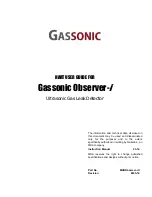
7
QUICK-START DEMONSTRATION
I. Supplies Needed
• a Nail
• a Zinc Penny (dated after 1982)
• a Nickel
• a Quarter
II. Position the Detector
a. Place the detector on a table, with the
searchcoil hanging over the edge.
Or better, have a friend hold the detector,
with the searchcoil off the ground.
b. Keep the searchcoil away from walls,
floors and metal objects.
c. Remove watches, rings and jewelry.
d. Turn off lights or appliances, whose
electromagnetic emissions may cause interference.
e. Pivot the searchcoil back.
III. Power Up. Press
IV. Wave each object over the searchcoil
a. Notice a different tone for each object:
Low Tone:
Medium Tone:
High Tone:
Nail
Zinc Penny, Nickel
Quarter
b. Motion is required.
Objects must be in motion over the searchcoil to be detected.
V. Then press
a. The word “IRON” disappears from the display
VI. Wave the nail over the searchcoil
a. The nail will not be detected
b. The nail has been “discriminated out.”
VII. Press
four more times
a. The words FOIL, 5¢, ALUM and ZINC disappear.
VIII. Wave the Nickel
a. The Nickel will not be detected.
IX. Press
to toggle down to NOTCH
Then press
3 times
a. 5¢ reappears on the display
X. Wave the Nickel
a. The Nickel is now again detected.
b. The Nickel has been “notched in.”
14
READING THE DISPLAY
The Liquid Crystal Display (LCD) shows the
PROBABLE identification of the targeted
metal, as well as the PROBABLE depth of
the target.
The detector will register a consistent target
identification, upon each sweep of the coil,
when a buried target has been located and
identified. If, upon repeated passes over
the same spot, the target identification
reads inconsistently, the target is probably
a trash item, or oxidized metal. With
practice, you will learn to unearth only the
repeatable signals.
The segment identifications are highly
accurate, when detecting the objects
described on the label. However, if an
object registers in a given category for an
unknown buried object, you could be
detecting a metallic object other than the
object described on the label, but with the
same metallic signature. Also, the greater
the distance between the target and the
coil, the less accurate the target
identification.
GOLD TARGETS
Gold objects will
register on the left side of the LCD scale.
Gold flakes
will register under iron.
Small gold items
will register under
foil or 5¢.
Medium-sized gold items
will
register between 5¢ and Alum.
Large gold items
will register under
Zinc.
SILVER TARGETS:
Silver objects will
register to the right of the scale, under
Dime, Qtrs. or 50¢+.
IRON:
All but the very largest iron objects
will register on the far-left side of the scale.
This could indicate a worthless item such as
a nail, or a more valuable historic iron relic.
FOIL:
Aluminum foil, such as a gum
wrapper, will register as foil. A small
broken piece of pull tab may also register
here.
NICKEL:
Most newer pull-tabs from
beverage cans, the type intended to stay
attached to the can, will register here. Many
gold rings will also register here.
PT:
Older pull tabs, which always
detached completely from the can, register
here. Many medium size gold ring also
register here.
ZINC:
Newer US pennies (post-1982),
and Canadian $1 and $2 coins register
here. Many non-US coins of recent vintage
will also register here.
DIME:
Dimes and older copper pennies
(pre-1982) register here.
50¢+ Qts:
Quarters register here, Silver
Dollars, Half-Dollars and very large iron
objects, like a sewer lid, will register here.
Caution:
The target indications are visual
references. Many other types of metal can
fall under any one of these categories.
While the detector will eliminate or indicate
the presence of most common trash items,
it is impossible to accurately classify ALL
buried objects.
DEPTH INDICATOR:
The Depth Indicator is
accurate for coin-sized objects. It indicates
the depth of the target, in inches.
Large and irregularly-shaped objects will
yield less reliable depth readings
When passing over an object, the
indicators will light up and stay illuminated
for three seconds. If the depth indication
varies with each sweep, try sweeping at
different angles; there may be more than
one target present. With practice, you will
learn the difference between accurate
readings, multiple targets and highly erratic
readings which evidence trash or
irregularly shaped objects.
DEPTH AND TARGET DISPLAY





































